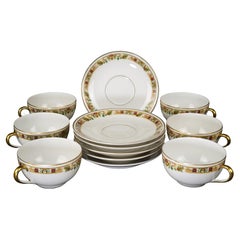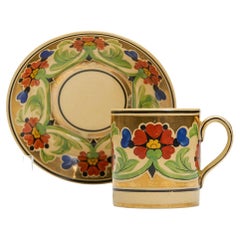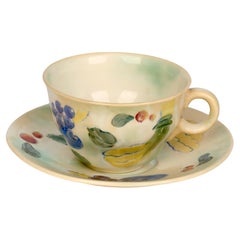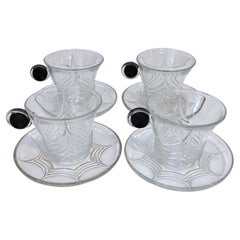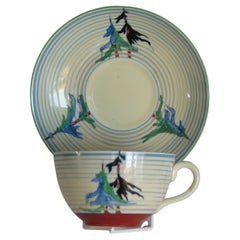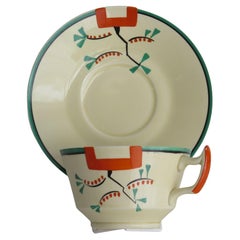Art Deco Cup And Saucer
Early 20th Century Art Deco Porcelain
Porcelain
Early 20th Century French Art Deco Porcelain
Porcelain
Vintage 1930s English Art Deco Ceramics
Stoneware
Vintage 1930s English Art Deco Ceramics
Stoneware
Vintage 1930s English Art Deco Tea Sets
Pottery
Early 20th Century Czech Art Deco Barware
Porcelain
20th Century American Art Deco Glass
Glass
Early 20th Century British Art Deco Pottery
Pottery
Early 20th Century British Art Deco Pottery
Pottery
Vintage 1920s French Art Deco Sheffield and Silverplate
Silver Plate
20th Century Japanese Art Deco Porcelain
Porcelain
Vintage 1930s Swedish Art Deco Tea Sets
Ceramic
Vintage 1920s French Art Deco Sheffield and Silverplate
Silver Plate
Vintage 1930s Polish Art Deco Porcelain
Glass
Vintage 1920s French Art Deco Sheffield and Silverplate
Silver Plate
Vintage 1930s German Porcelain
Porcelain
Mid-20th Century Italian Art Deco Porcelain
Porcelain
Early 20th Century English Art Deco Tea Sets
Ceramic
Antique Late 19th Century French Art Deco Porcelain
Porcelain
Vintage 1920s Czech Art Deco Porcelain
Porcelain
Vintage 1950s Czech Art Deco Desk Sets
Porcelain
Vintage 1950s Czech Art Deco Desk Sets
Porcelain
Vintage 1920s English Art Deco Porcelain
Silver
Mid-20th Century Italian Mid-Century Modern Porcelain
Gold Leaf
Mid-20th Century Italian Mid-Century Modern Porcelain
Gold Leaf
Vintage 1920s Portuguese Art Deco Porcelain
Porcelain
Vintage 1980s French Art Deco Porcelain
Porcelain
Vintage 1940s Swedish Art Deco Tableware
Ceramic
Vintage 1940s Swedish Art Deco Tableware
Ceramic
Vintage 1960s German Art Deco Porcelain
Gold Leaf
1990s French Art Deco Tea Sets
Ceramic
Mid-20th Century Portuguese Mid-Century Modern Tea Sets
Porcelain
21st Century and Contemporary Turkish Art Deco Porcelain
Porcelain
Early 20th Century Swedish Art Deco Serving Pieces
Ceramic
Mid-20th Century Japanese Art Deco Tea Sets
Ceramic
Vintage 1930s Italian Art Deco Porcelain
Porcelain
Early 20th Century English Art Deco Pottery
Pottery
Vintage 1930s German Mid-Century Modern Tea Sets
Pottery
Vintage 1920s French Art Deco Tea Sets
Porcelain
Mid-20th Century Slovak Art Deco Porcelain
Porcelain
Vintage 1920s French Art Deco Porcelain
Porcelain
Vintage 1930s English Art Deco Tea Sets
Paste, Porcelain
Vintage 1930s Art Deco Tea Sets
Majolica
Vintage 1930s English Art Deco Porcelain
Gold
Vintage 1930s Czech Art Deco Porcelain
Porcelain
Vintage 1930s English Art Deco Porcelain
Porcelain
Early 20th Century French Art Deco Tableware
Gold Leaf
Vintage 1930s Swedish Art Deco Porcelain
Porcelain
Vintage 1910s English Art Deco Porcelain
Porcelain
Vintage 1920s German Art Deco Tea Sets
Porcelain
Vintage 1920s Dutch Art Deco Tea Sets
Ceramic
Vintage 1940s Italian Art Deco Porcelain
Porcelain
Mid-20th Century American Art Deco Tableware
Glass, Plastic
Vintage 1960s Italian Mid-Century Modern Porcelain
Brass
Vintage 1920s English Art Deco Tea Sets
Porcelain
Early 20th Century English Art Deco Tea Sets
Porcelain
Vintage 1930s French Art Deco Serving Pieces
Ceramic
Early 20th Century French Dinner Plates
Porcelain
- 1
Art Deco Cup And Saucer For Sale on 1stDibs
How Much is a Art Deco Cup And Saucer?
A Close Look at Art Deco Furniture
Art Deco furniture is characterized by its celebration of modern life. More than its emphasis on natural wood grains and focus on traditional craftsmanship, vintage Art Deco dining chairs, tables, desks, cabinets and other furniture — which typically refers to pieces produced during the 1920s and 1930s — is an ode to the glamour of the “Roaring Twenties.”
ORIGINS OF ART DECO FURNITURE DESIGN
- Emerged in the 1920s
- Flourished while the popularity of Art Nouveau declined
- Term derives from 1925’s Exposition Internationale des Arts Décoratifs et Industriels Modernes (International Exhibition of Modern Decorative and Industrial Arts) in Paris, France
- Informed by Ancient Egypt, Cubism, Futurism, Louis XVI, De Stijl, modernism and the Vienna Secession; influenced Streamline Moderne and mid-century modernism
CHARACTERISTICS OF ART DECO FURNITURE DESIGN
- Bold geometric lines and forms, floral motifs
- Use of expensive materials such as shagreen or marble as well as exotic woods such as mahogany, ebony and zebra wood
- Metal accents, shimmering mirrored finishes
- Embellishments made from exotic animal hides, inlays of mother-of-pearl or ivory
ART DECO FURNITURE DESIGNERS TO KNOW
VINTAGE ART DECO FURNITURE ON 1STDIBS
Few design styles are as universally recognized and appreciated as Art Deco. The term alone conjures visions of the Roaring Twenties, Machine Age metropolises, vast ocean liners, sleek typography and Prohibition-era hedonism. The iconic movement made an indelible mark on all fields of design throughout the 1920s and ’30s, celebrating society’s growing industrialization with refined elegance and stunning craftsmanship.
Widely known designers associated with the Art Deco style include Émile-Jacques Ruhlmann, Eileen Gray, Maurice Dufrêne, Paul Follot and Jules Leleu.
The term Art Deco derives from the name of a large decorative arts exhibition held in Paris in 1925. “Art Deco design” is often used broadly, to describe the work of creators in associated or ancillary styles. This is particularly true of American Art Deco, which is also called Streamline Moderne or Machine Age design. (Streamline Moderne, sometimes known as Art Moderne, was a phenomenon largely of the 1930s, post–Art Nouveau.)
Art Deco textile designers employed dazzling floral motifs and vivid colors, and while Art Deco furniture makers respected the dark woods and modern metals with which they worked, they frequently incorporated decorative embellishments such as exotic animal hides as well as veneers in their seating, case pieces, living room sets and bedroom furniture.
From mother-of-pearl inlaid vitrines to chrome aviator chairs, bold and inventive works in the Art Deco style include chaise longues (also known as chaise lounges) and curved armchairs. Today, the style is still favored by interior designers looking to infuse a home with an air of luxury and sophistication.
The vintage Art Deco furniture for sale on 1stDibs includes dressers, coffee tables, decorative objects and more.
Finding the Right Serveware, Ceramics, Silver And Glass for You
Your dining room table is a place where stories are shared and personalities shine — why not treat yourself and your guests to the finest antique and vintage glass, silver, ceramics and serveware for your meals?
Just like the people who sit around your table, your serveware has its own stories and will help you create new memories with your friends and loved ones. From ceramic pottery to glass vases, set your table with serving pieces that add even more personality, color and texture to your dining experience.
Invite serveware from around the world to join your table settings. For special occasions, dress up your plates with a striking Imari charger from 19th-century Japan or incorporate Richard Ginori’s Italian porcelain plates into your dining experience. Celebrate the English ritual of afternoon tea with a Japanese tea set and an antique Victorian kettle. No matter how big or small your dining area is, there is room for the stories of many cultures and varied histories, and there are plenty of ways to add pizzazz to your meals.
Add different textures and colors to your table with dinner plates and pitchers of ceramic and silver or a porcelain lidded tureen, a serving dish with side handles that is often used for soups. Although porcelain and ceramic are both made in a kiln, porcelain is made with more refined clay and is more durable than ceramic because it is denser. The latter is ideal for statement pieces — your tall mid-century modern ceramic vase is a guaranteed conversation starter. And while your earthenware or stoneware is maybe better suited to everyday lunches as opposed to the fine bone china you’ve reserved for a holiday meal, handcrafted studio pottery coffee mugs can still be a rich expression of your personal style.
“My motto is ‘Have fun with it,’” says author and celebrated hostess Stephanie Booth Shafran. “It’s yin and yang, high and low, Crate & Barrel with Christofle silver. I like to mix it up — sometimes in the dining room, sometimes on the kitchen banquette, sometimes in the loggia. It transports your guests and makes them feel more comfortable and relaxed.”
Introduce elegance at supper with silver, such as a platter from celebrated Massachusetts silversmith manufacturer Reed and Barton or a regal copper-finish flatware set designed by International Silver Company, another New England company that was incorporated in Meriden, Connecticut, in 1898. By then, Meriden had already earned the nickname “Silver City” for its position as a major hub of silver manufacturing.
At the bar, try a vintage wine cooler to keep bottles cool before serving or an Art Deco decanter and whiskey set for after-dinner drinks — there are many possibilities and no wrong answers for tableware, barware and serveware. Explore an expansive collection of antique and vintage glass, ceramics, silver and serveware today on 1stDibs.
